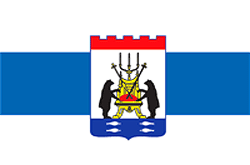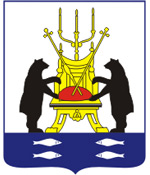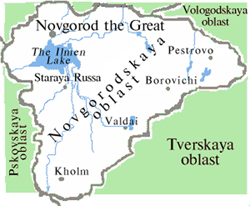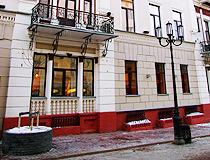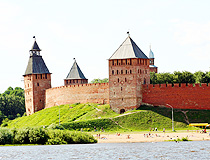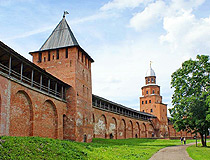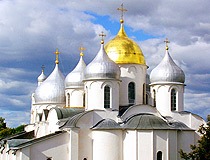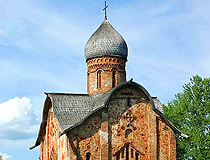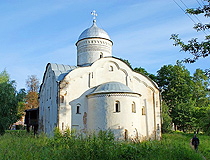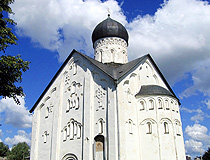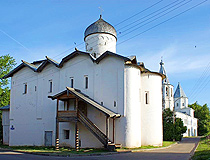History of Veliky Novgorod
Foundation of Novgorod and the Novgorod Republic
The official founding year of Novgorod is 859, when it was first mentioned in the chronicle. In 862, the so-called “vocation of the Varangians” led by Rurik took place on Novgorod land, which was the beginning of the formation of the Old Russian state. In 882, after the death of Rurik, Prince Oleg became the ruler of Novgorod. He captured Kiev and moved the capital of the state to it. It was the beginning of the Kievan Rus state.
Novgorod was the second town of the Kievan Rus by cultural, economic, and political influence. In 1045-1050, the Cathedral of St. Sophia was built - the main Orthodox church of Novgorod and one of the oldest preserved stone churches in Russia.
The convenient location of Novgorod at the intersection of trade routes “from the Varangians to the Greeks” made it the largest center of intra-Russian and international trade. Constant contacts of the town with the island of Gotland, German towns and the Hansa led to the opening of the first foreign missions on the territory of Novgorod.
The first attempts of Novgorod to gain independence from the Kievan Rus were taken in the 11th century. Novgorod boyars, with the support of the local population, wanted to get rid of the burden of Kiev taxation and to create their own army. In 1136, due to the retreat of Prince Vsevolod Mstislavovitch from the battlefield at Zhdanaya mountain, he was exiled from Novgorod, and a republican government was established in the region.
From 1136 to 1478, Novgorod was the capital of the Russian medieval state known as the Novgorod Republic. In the 12th century, the Novgorod land included part of the Baltic, part of Karelia, the southern part of Finland, the southern coast of Lake Ladoga, the banks of the Northern Dvina River, and vast areas of the European north up to the Urals.
More Historical Facts…
During the Mongol invasion of Rus, Novgorod avoided destruction due to its remote location. It was the only old Russian town that avoided decline in the 11th-12th centuries. In 1259, with the support of Prince Alexander Nevsky, the Mongols conducted a census in Novgorod to collect tribute. In 1280, in Novgorod, a document was drawn up known as “Russian Truth” - the very first set of laws in Russia. Until the 15th century, Novgorod’s possessions expanded to the east and northeast.
Areas northeast of Novgorod were rich in fur-bearing animals and salt. These resources were of great importance for the economy of the Novgorod Republic, which was based on trade. The town was part of the trade route from Scandinavia to Byzantium. The Russian folk hero Sadko was a merchant from Novgorod.
The Novgorod Republic was characterized by some features of the social system and feudal relations: a significant social and landowning weight of the Novgorod boyars and their active participation in trade and other activities. The main economic factor was not land, but capital. This led to a special social structure of society and an unusual form of government for medieval Rus.
The veche - a gathering of a part of the male population of the town - had broad powers. It invited, judged and expelled Novgorod princes; elected the mayor and the military leader; resolved issues of war and peace; passed and repealed laws; set the size of taxes and duties; elected representatives of the authorities in the Novgorod lands and tried them.
From the 14th century, the Tver and Moscow principalities, and the Grand Duchy of Lithuania attempted to subdue the Novgorod Republic. In 1470, Novgorod people asked the Metropolitan of Kiev to appoint a bishop for them (Kiev belonged to the Grand Duchy of Lithuania at that time). After it, Ivan III, the Grand Prince of Moscow, accused them of treason. In 1471, he announced a military campaign against Novgorod. Moscow troops defeated Novgorod militia during the battle on the Shelon River and took the town.
In 1478, after a series of wars against Moscow, Novgorod lost its independence and the Novgorod Republic ceased to exist. The veche was abolished, the veche bell was taken to Moscow; power in the town was granted to the governors appointed by the Grand Prince of Moscow. A lot of boyar families were expelled from Novgorod.
Novgorod in the 16th-19th centuries
The oprichnina pogrom perpetrated in the winter of 1569/1570 by the army personally headed by Ivan the Terrible inflicted enormous damage on Novgorod. The reason for the pogrom was a denunciation and suspicion of treason. The town was plundered, the property of churches, monasteries and merchants was confiscated, thousands of residents were killed. In 1571, the population of Novgorod was about 5,000 people.
From 1611 to 1617, during the Time of Troubles, Novgorod was occupied by the Swedes. After the occupation, half of the town was burnt down. The population decreased to only about 500 residents. Nikon (the most famous Russian Patriarch) was the metropolitan of Novgorod in 1648-1652.
In 1700, the Great Northern War began. After the defeat at Narva, Peter I hastily prepared the fortifications of Novgorod for a possible siege of the Swedes. Swedish troops did not reach Novgorod; nevertheless, the Novgorod regiment played an important role in the Battle of Poltava in 1709.
In 1703, in connection with the founding of St. Petersburg, the new capital of Russia, a lot of craftsmen from Novgorod were involved in its construction. At the same time, Novgorod finally lost its former importance as a trade center and turned into an ordinary provincial town. In 1727, a separate Novgorod Governorate was formed with its center in Novgorod.
In the first half of the 19th century, Novgorod became the center of military settlements. At the same time, there was almost no industrial production in the town. In 1841-1842, the writer Alexander Herzen was in exile in Novgorod.
One of the brightest pages in the history of Veliky Novgorod in the 19th century was the celebration of the 1000th anniversary of the Russian state in 1862. In honor of this event, a monument to the Millennium of Russia was erected in the center of the Novgorod Kremlin. In 1875, 17,384 people lived in Novgorod, along with military units. 12 small enterprises employed only 63 workers.
Novgorod in the 20th century
Despite the increased interest in its history, Novgorod both at the end of the 19th century and at the beginning of the 20th century remained a typical provincial town of the Russian Empire, despite its status as a regional capital. In 1914, the population of Novgorod was about 28,200 people.
In 1927, as a result of the administrative-territorial reform carried out in the USSR, the Novgorod Governorate became part of Leningrad Oblast. The Leningrad leadership viewed the Novgorod land as a rural region. No industrialization was planned.
From August 15, 1941 to January 20, 1944, during the Second World War, Novgorod was occupied by German and Spanish troops (“The Blue Division”). The war caused huge and in many ways irreparable damage to the monuments of the city itself and its environs. All wooden buildings burned down. The most valuable collections of archeology, history and art were plundered from the Novgorod museum, which was not completely evacuated in time. Almost the entire city infrastructure and industrial enterprises were destroyed, world famous monuments of Novgorod architecture were turned into ruins.
On July 5, 1944, Novgorod Oblast was formed. The transformation of Novgorod into the administrative and economic center of a separate region had a beneficial effect on the acceleration of its restoration. On November 1, 1945, Novgorod was included in the list of 15 Soviet cities subject to priority restoration. In addition, a special decree was issued on the restoration of architectural monuments. One of the first to be restored was the Millennium of Russia monument.
In the post-war years, the presence of large undeveloped areas and wastelands after the dismantling of the rubble of destroyed buildings in the city center made it possible to begin extensive archaeological research. The results of these studies were numerous finds of objects of old Russian art and everyday life. One of the most important finds was the discovery of the first birch bark letter on July 26, 1951. Archaeological research continues to this day.
In the 1950s-1970s, the main restoration work of architectural monuments was carried out. Novgorod became known as the center of all-Union and international tourism. In 1964, not far from the old Yuryev Monastery on the shore of Lake Myachino, the creation of the Vitoslavlitsy Museum of Folk Wooden Architecture began. In 1967, the population of the city was about 107,000 people.
In 1992, 37 unique monuments of old Russian culture in Novgorod were included in the UNESCO World Cultural Heritage List. The population of the city reached its maximum and amounted to 235 thousand people.
On June 11, 1999, the President of the Russian Federation Boris Yeltsin signed the federal law “On renaming the city of Novgorod, the administrative center of Novgorod Oblast, into the city of Veliky Novgorod.” Also in the 1990s, a lot of streets in the city center received their historical names back.
Monuments of Veliky Novgorod
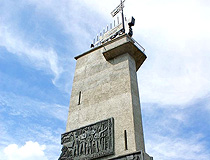
Victory Monument in Veliky Novgorod
Author: Sergey Duhanin
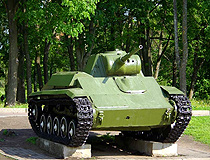
Light tank T-70 in Veliky Novgorod
Author: Konstantin Matekhin
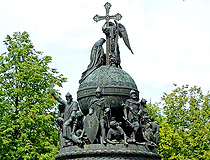
Monument to the Millennium of Russia in Veliky Novgorod
Author: Sergey Duhanin
Veliky Novgorod - Features
Veliky Novgorod is deservedly called “the father of Russian cities”. In this place the Russian statehood was born. The city stands on the banks of the Volkhov River, 6 km from Lake Ilmen, 575 km north-west of Moscow and 190 km south-east of St. Petersburg. Due to similar names, Veliky Novgorod is often confused with Nizhny Novgorod. And this applies not only to foreigners, but also to residents of Russia.
The Volkhov River divides the city into two parts: Sofia and Torgovaya (Trade) sides. The Sofia side got its name from the Sofia Cathedral, which is about one thousand years old. The main part of the city is located here, including the Novgorod Kremlin and the historic center, as well as new districts.
In the old days, there was a large market on the Trade side - Torg. Today, it is built up mainly with private houses. The Yaroslav’s Courtyard is also located here. It is a historical and architectural complex on the site where the residence of Yaroslav the Wise (Prince of Novgorod in 988-1015) used to be.
The climate of Veliky Novgorod is moderately continental, with cold snowy winters and moderately warm summers. The average temperature in January is minus 9.2 degrees Celsius, in July - plus 17.3 degrees Celsius.
Novgorod Oblast has a unique transport and geographical position. The main highway, rail, air, and water transport routes connecting St. Petersburg and Moscow pass through its territory. Public transport in the city is represented by buses, trolleybuses.
The region’s largest employer is the chemical fertilizer plant “Acron”, which produces ammonia, saltpeter, nitric acid, and other substances. This enterprise is one of the world’s largest fertilizer producers. The plant in Veliky Novgorod employs about 5 thousand people.
Tourism is gradually becoming more and more important in the city’s economy. Veliky Novgorod is rightly called the city-museum of Old Rus. No other city in Russia has so many remarkable architectural monuments and monumental paintings of the 11th-17th centuries. The architecture of Veliky Novgorod is unique because a lot of old churches have survived here. A significant part of them were erected in the period from the 11th to the 16th centuries. In some churches, old wall paintings have been preserved, which are of great cultural value.
The main discovery made on the territory of Veliky Novgorod is more than 1,000 preserved birch bark letters of various contents written in the 11th-15th centuries. These include business letters, love letters, recipe notes, Bible commentaries, commercial calculations, and even student scribbles.
Main Attractions of Veliky Novgorod
Novgorod Detinets (Kremlin) - the fortress of Veliky Novgorod located on the left bank of the Volkhov River, the oldest preserved kremlin in Russia and the most northern one. The first mention of it in chronicles dates back to 1044. It is an architectural monument of federal significance. Novgorod Detinets as part of the historic center of Veliky Novgorod is included in the UNESCO World Heritage List.
The construction of the stone fortress was completed by the end of the 15th century. About 1.5 kilometers of fortress walls, nine towers, and old churches have survived to this day. A road going through the Novgorod Kremlin leads to the bridge connecting the Sofia and Torgovaya sides of the city. The 41-meter watchtower known as “Kokuy” offers a great view of the entire city and its surroundings.
Today, it is the cultural and tourist center of Veliky Novgorod. Here you can find the main expositions of the Novgorod Museum-Reserve (the exposition of the Old Russian arts and crafts and jewelry in the Chamber of Facets; “History of the Novgorod Region”, “Old Russian icon painting”, “Russian art of the 18th-20th centuries”), restoration workshops, a library, philharmonic society, college of arts, and a music school. The Novgorod Kremlin is surrounded by a spacious park. A walk from the railway station to the Novgorod Kremlin takes about 20 minutes.
Saint Sophia Cathedral (1045-1050) - the main Orthodox church in Veliky Novgorod located on the territory of the Novgorod Kremlin, one of the oldest churches in Russia. Churches of this type were built in Rus only in the 11th century. Sophia Cathedral was built in the Byzantine style, has a pyramidal structure and 6 domes. This is one of the symbols of Veliky Novgorod.
The belfry of St. Sophia Cathedral rises above the Novgorod Kremlin in the form of a wall with five spans in the upper part. This type of structure was invented during the reign of the Novgorod Archbishop Euthymius II and then repeated in Russia only twice.
Monument to the Millennium of Russia (1862) - a magnificent monument more than 15 meters high erected opposite the St. Sophia Cathedral in honor of the millennium anniversary of the legendary vocation of the Varangians to Rus. The monument consists of 128 figures. At the very top you can see an angel - the personification of Orthodoxy and a woman depicting Rus, below - princes, church hierarchs and enlighteners, who took part in important historical events that happened over the thousand-year history of Russia.
Yaroslav’s Courtyard and Torg - an architectural complex located opposite the Novgorod Kremlin, on the other bank of the Volkhov River. Both banks are connected by a pedestrian bridge. Several monuments of the 12th-16th centuries have survived on its territory, including the Nikolsky Cathedral (1113) and the Church of Paraskeva Pyatnitsa (the 13th century). The place was named after Prince Yaroslav the Wise. In old times, fairs were held here. The most recent construction is the arcade of the Gostiny Dvor, which consists of several dozen white-stone arches.
St. George’s (Yuriev) Monastery. Founded in 1030, it is one of the oldest monasteries in Russia, a cultural heritage site of federal significance. The monastery is located on the southern outskirts of Veliky Novgorod on the bank of the Volkhov River. On the territory of the monastery there are St. George, Spassky, and Holy Cross Cathedrals, a four-tiered bell tower 52 m high, and several old churches. Crowned with three silvery domes, St. George’s Cathedral is a wonderful example of Old Russian architecture. The Vitoslavlitsy Museum is located nearby. Yur’yevskoye Highway, 10.
Museum of Folk Wooden Architecture “Vitoslavlitsy”. This open-air exhibition was opened in 1964. 22 wooden architectural monuments of the 16th-20th centuries - churches, residential buildings, and outbuildings - were brought here from different districts of the Novgorod region.
Inside the peasant huts, you can see recreated old interiors: “Winter Life”, “Wedding”, “Wool Felting Craft”, and others. Folk festivals are also held on the territory of the museum. On the second floor of the souvenir shop there is the Museum of Irons with a unique collection of irons of the 18th-20th centuries. Yur’yevskoye Highway, 14.
Center for Musical Antiquities named after V.I. Povetkin. The unique collection of this museum acquaints visitors with the old musical instruments of Rus. Here you can also hear old Russian music. Most of the exhibits date back to the 10th-15th centuries. For the guests of the center, folk songs of the Russian North-West and North are performed. Choir concerts are held on holidays. Il’ina Street, 9b.
Art Museum. The permanent exhibition of this museum is dedicated to Russian art of the 17th-20th centuries. It was opened in the historic building of the Noble Assembly in 2001. The rich collection of the museum includes paintings, drawings, sculptures, miniatures, etc.
Among the most valuable exhibits are paintings created by such masters as K. Bryullov, I. Repin, A. Aivazovsky and sculptures, including M. Antokolsky and M. Vrubel. The museum’s collection of Russian art objects is considered one of the best outside Moscow and St. Petersburg. Sofiyskaya Square, 2.
Museum of Artistic Culture of the Novgorod Land. This museum was opened in one of the buildings of the Desyatinnyy monastery in 2002. The exposition is composed of works by Novgorod artists of the late 20th - early 21st centuries. In addition to paintings, visitors can look at porcelain and glass products made by local craftsmen. Desyatinnyy Lane, 6.


